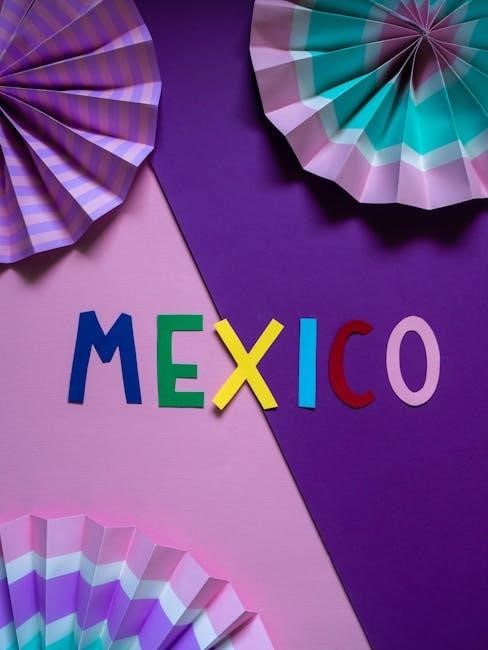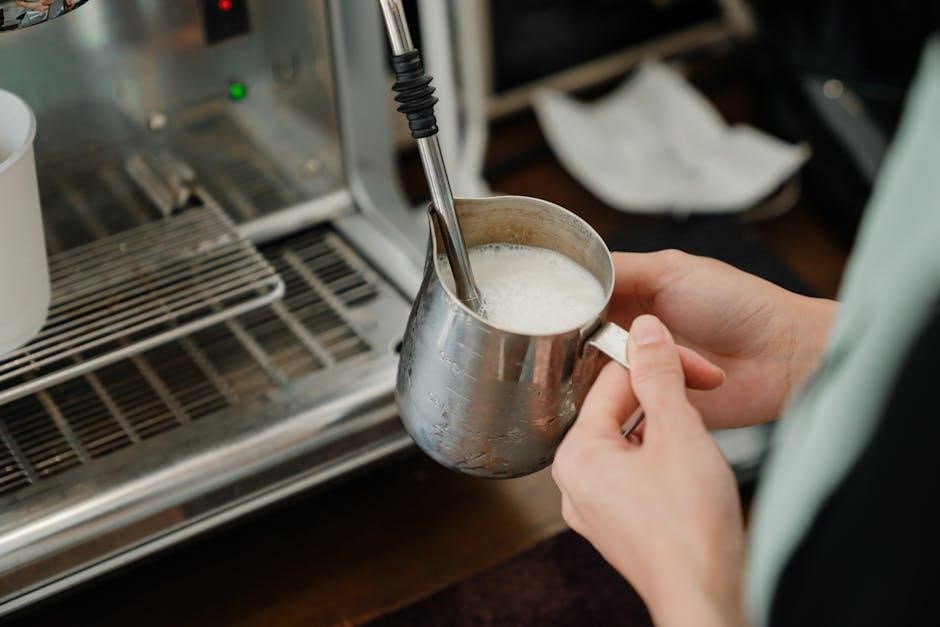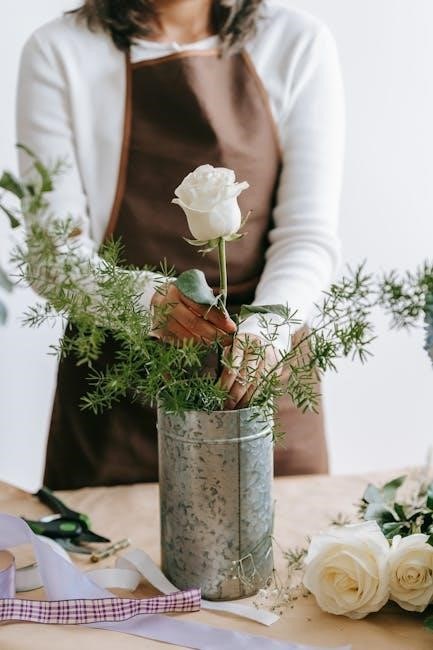how to make papel picado pdf
How to Make Papel Picado PDF: A Step-by-Step Guide
Learn to create vibrant Papel Picado banners by designing templates, printing, and cutting tissue paper. Layer sheets, fold, and cut intricate designs, then string them together for a festive display.
Papel picado, meaning “cut paper” in Spanish, is a traditional Mexican folk art that involves creating intricate designs on tissue paper. These delicate, colorful banners are often displayed during celebrations like Día de Muertos (Day of the Dead), fiestas, and weddings. Originating from European paper-cutting traditions, papel picado has evolved into a unique Mexican craft, symbolizing joy, culture, and creativity. Artisans spend years mastering the skill of cutting intricate patterns, which are then strung together to create vibrant decorations. The craft reflects Mexico’s rich cultural heritage and continues to be a popular art form today, adapting to modern uses while preserving its traditional essence. This guide will walk you through the process of creating your own papel picado, ensuring you can bring this festive tradition into your home or celebrations.

Materials and Tools Needed
To create papel picado, you will need a few essential materials and tools. Start with colorful tissue paper, available in various hues, which forms the foundation of your designs. You’ll also need sharp scissors or a craft knife for intricate cutting. A pencil is useful for sketching patterns on the paper before cutting. Folded paper or pre-made templates can help achieve symmetrical designs. For assembling the banner, use a string or ribbon to hang the cutouts. Additional tools like glue sticks or tape may be needed for securing layers or attaching the designs to the string. Optional items include stencils for complex patterns or a ruler for precise cuts. Ensure all tools are child-safe if involving young participants. These simple materials are all you need to craft beautiful papel picado banners for any celebration.

Step-by-Step Guide to Creating Papel Picado
Start by designing your pattern on paper or using a template. Fold tissue paper layers, then cut intricate designs. Unfold, string the pieces together, and hang your vibrant banner.
Cutting the Paper Designs
Cutting papel picado requires precision and patience. Begin by folding the tissue paper into layers, ensuring alignment for consistent cuts. Use sharp scissors or a craft knife to carefully follow your drawn or printed design. Cut along the lines, creating intricate patterns and shapes. For complex designs, work slowly to avoid errors. Once cuts are complete, unfold the paper to reveal the delicate, lace-like design. To achieve symmetry, fold the paper along a central line before cutting. This step is crucial for creating balanced and visually appealing patterns. Remember, the more layers you cut simultaneously, the more uniform your final banner will look. Practice makes perfect, so don’t be discouraged if early attempts aren’t flawless.
Folding and Layering the Paper
Folding and layering tissue paper is essential for creating uniform cuts in papel picado. Start by stacking multiple sheets of tissue paper, ensuring they are evenly aligned. Fold the stack in half along the longer side, then fold it again to create additional layers. This method allows you to cut through several layers at once, resulting in identical designs. For intricate patterns, fold the paper into accordion-style pleats, which help achieve symmetrical cuts. When folding, use a ruler or straightedge to ensure crisp creases. Layering also enhances the banner’s visual impact, as each layer adds depth and dimension. Proper folding and layering techniques are key to producing professional-looking papel picado designs. Experiment with different folding methods to achieve varying effects, from simple to complex patterns.
Assembling the Banner
Assembling the banner is the final step in creating your papel picado. Once all the cut paper designs are ready, fold the top edge of each piece over a ribbon or string, securing it with a small amount of glue or tape. Repeat this process for each design, spacing them evenly along the ribbon. For a more polished look, align the edges carefully to ensure the banner hangs straight. To add extra flair, alternate colors or patterns for a vibrant display. If desired, attach multiple layers of papel picado to create a fuller appearance. Finally, tie the ends of the ribbon to secure the banner and hang it in your desired location. Proper assembly ensures your papel picado is both visually striking and durable for celebrations or decorations.
Finishing Touches
Once your papel picado designs are cut and assembled, add finishing touches to enhance their appearance. Lightly apply glue or tape to the top edge of each paper strip to secure it to the ribbon or string. Trim any uneven edges with scissors for a polished look. For extra flair, sprinkle glitter or add small beads along the cuts. To protect the banner from moisture, lightly spray with a clear acrylic sealant. Allow it to dry completely before hanging. Finally, tie the ends of the ribbon to prevent the strips from sliding off. Your papel picado is now ready to decorate any celebration, adding a vibrant and traditional touch to the occasion.

Design Templates and Patterns
Explore various pre-made templates and traditional patterns for papel picado, featuring intricate floral motifs, geometric shapes, and cultural symbols. Find inspiration in Mexican folk art designs.
Using Pre-Made Templates
Pre-made templates are an excellent way to simplify the papel picado creation process. These templates are readily available online and can be downloaded as PDF files, offering a variety of designs. They often feature traditional Mexican motifs, such as floral patterns, geometric shapes, and cultural symbols. Simply print the templates on tissue paper or lightweight cardstock and cut along the pre-drawn lines. This method is ideal for beginners or those short on time. Many templates are customizable, allowing you to add personal touches or adjust colors to match your theme. They are perfect for creating uniform and professional-looking banners for parties, fiestas, or educational projects. By using pre-made templates, you can focus on assembling and decorating rather than designing from scratch.
Creating Custom Designs
For those who want to add a personal touch, creating custom designs for papel picado allows for endless creativity. Start by sketching your design on paper or using graphic design software. Incorporate meaningful symbols, patterns, or themes that reflect your celebration or personal style. Once your design is finalized, transfer it onto tissue paper or cardstock and cut out the shapes. You can layer multiple sheets to create intricate patterns. Custom designs are perfect for special occasions like weddings, birthdays, or cultural events. To make it reusable, save your design as a PDF template for future projects. This method ensures your papel picado is unique and tailored to your preferences, making it a standout decoration for any event.
Cultural Significance and Modern Uses
Papel picado holds deep cultural meaning in Mexico, symbolizing joy and celebration during festivals like Día de Muertos. Today, it’s widely used in parties, educational projects, and global events.
History and Symbolism
Papel picado, or “cut paper,” originates from Mexico, influenced by European and Chinese traditions. It symbolizes the fleeting nature of life, often used in Día de Muertos to honor ancestors. Vibrant designs and intricate cuts reflect cultural pride and celebrations. Historically, artisans spent years mastering the craft, creating banners for festivals and special occasions. Each cut and color carries meaning, contributing to its cultural significance. Today, papel picado bridges tradition and modern celebrations worldwide.
Modern Applications

Papel picado has evolved beyond traditional celebrations, becoming a popular decorative element in modern events. Today, it is widely used in parties, weddings, and cultural festivals worldwide. Its vibrant designs and ease of customization make it a favorite for themed events. Additionally, papel picado is incorporated into educational projects, teaching students about Mexican culture and art. Many designers now offer digital templates for DIY enthusiasts, making it accessible to create personalized banners. The craft has also inspired contemporary artists, blending traditional techniques with modern aesthetics. Furthermore, papel picado is used in home decor, adding a festive touch to spaces. Its versatility and cultural significance ensure its continued relevance in both traditional and modern settings, appealing to a diverse audience seeking unique and meaningful decorations.
Crafting papel picado is a rewarding and creative process that connects you to Mexico’s rich cultural heritage. By following the steps outlined in this guide, you can easily create stunning banners for any occasion. Whether for a festive celebration or a personal project, papel picado adds a vibrant and meaningful touch. The process is both meditative and fulfilling, allowing you to express your creativity while preserving a traditional art form. With accessible materials and simple techniques, anyone can master this craft. Experiment with colors, patterns, and designs to make your papel picado truly unique. Share your creations with others, and enjoy the joy of handmade art that brings people together. Happy crafting!